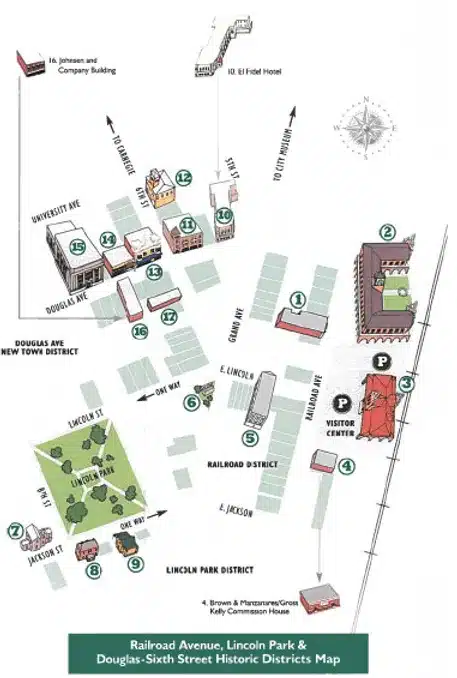District Three: Railroad Ave., Lincoln Park, Sixth Street
As the Atchison, Topeka and Santa Fe (AT&SF) Railroad steamed into Las Vegas on July 4, 1879, hundreds of new citizens descended on the "City of the Meadows." Overnight, a new town was born a mile east of the Plaza populated by families, merchants, professionals, desperados and dance hall girls,all hardy pioneers seeking their fortunes. Several thousand people came to Las Vegas that year, making it one of the largest town in the Rocky Mountain West, rivaling Albuquerque, Tucson, and El Paso in size. At first a town of tents and sheds, the new town, "East Las Vegas," was laid out within six months and lots were sold at a brisk price.
Las Vegas as a whole became an economic boom-town. Trade here earned the railroad $2,500,000 from shipping and $500,00 from passengers between 1886 and 1891. The railroad provided jobs for track construction, maintenance and locomotive crews, and headquarters officials, as well as seasonal employment in the ice industry.
Not only a bustling mercantile center, the railroad district also boasted hotels, saloons and dance halls with notorious characters to match. In 1879, Dodge City's most famous dentist, Doc Holiday, bought a saloon on Center Street (now East Lincoln) and fatally shot a man named Mike Gordon. Holiday returned to Kansas the following year.
The railroad brought modern technology to Las Vegas through improvements in communications and transportation, and new building materials and designs. Local businessmen and professionals installed telephones in their stores and offices the same year the railroad came to town. By 1881, the Las Vegas Street Railway was operating horse drawn streetcar service between the train depot and the Plaza, west of the Gallinas River. The most visible legacy of this technology can still be seen in the use of fired brick, structural cast iron and pressed metal in "new" construction.
Historic Railroad District
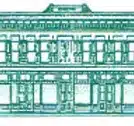 Rawlins Building, 515 Railroad Ave. (Built 1899)
Rawlins Building, 515 Railroad Ave. (Built 1899)
Though is deteriorated condition, the Rawlins Building remains outstanding an outstanding architectural landmark, and a potential new rehabilitation project. The building's pressed-metal front is one of the few left in New Mexico, and recessed storefronts are intact. The upper story boasts a row of engaged classical revival columns and swags. The Harvey girls who staffed La Castaneda's dining room across the street lived here for many years during the early 20th century.
Brown & Manzanares/Gross Kelly Commission House, 420 Railroad Ave. (Built 1898-99
Designed by the Rapp Brothers, architects whose work can be seen along the rail line from Pueblo, Colorado to Santa Fe, this building housed one of New Mexico's leading mercantile companies. Built in the World's Fair Classic style, its remarkable second story loggia (row or Classical Ionic columns) is an elegant feature. A cast-in-place concrete warehouse was added about 20 years after the original construction. Acquired by the Public Service Company of New Mexico (PNM) in 1982 to house its headquarters, the building received extensive repairs to the exterior masonry and interior oak woodwork. The restoration won many awards, including a New Mexico Governor's Award.
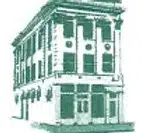 Wells Fargo Building, 615 E. Lincoln (Built 1908)
Wells Fargo Building, 615 E. Lincoln (Built 1908)
This building is a rare example of a three-story Classical Revival style commercial structure. Elegantly carved Corinthian capitals flank the main entrance. The front and the alley facades are well designed and boast exceptional brickwork and terra-cotta medallions. Notice the alley facade orients to the rail-yard so that incoming train traffic could immediately identify the Well Fargo site. Doc Holiday owned a saloon just to the right of this building in 1879.
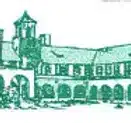 La Castaneda Hotel, 524 Railroad Ave. (Built 1898)
La Castaneda Hotel, 524 Railroad Ave. (Built 1898)
Built to be a jewel in Fred Harvey's famed chain of AT&SF railroad hotels, La Castaneda is the first of the early Harvey Houses to be built in the Spanish Mission Revival style in New Mexico and the first Spanish Mission Revival style in New Mexico and the first Spanish Mission Revival building in the state. Its main facade and courtyard face the railroad tracks. La Castaneda was a sister hotel to Albuquerque's later Alvarado Hotel, which was demolished in 1970. The hotel was the site of the first Rough Rider Reunion in 1899, attended by New York Governor Theodore Roosevelt, who served as Lt. Colonel for the Rough Riders. A major rehabilitation and reopening of the Castaneda Hotel is planned.
 Las Vegas Railroad Depot and Visitor Center (Built 1899)
Las Vegas Railroad Depot and Visitor Center (Built 1899)
Similar to la Castaneda Hotel with its curvilinear gables, the Las Vegas Railroad Depot was completed one year later. The City of Las Vegas completed a major renovation of the depot in 2003. It is now the City's intermodal transportation facility and Visitor Center; and Amtrak stops here twice a day.
 Lion Park, Corner Grand & W. Lincoln (1886)
Lion Park, Corner Grand & W. Lincoln (1886)
Founded in 1885 to protest the proliferation of saloons and public drinking, the Women's Christian Temperance Union performed many good social projects. According to Las Vegas historian Lynn Perrigo, "The ladies of the WCTU came up with the idea... that a public drinking fountain located in Las Vegas near the saloons would serve as an alternate thirst-quencher that would reduce the patronage of the bars. They raised funds, engaged Angelo da Tullio as sculptor and had a stone lion erected... with projecting drinking fountains and a stone trough." The park was dedicated on Dec. 16 1886. Efforts are presently underway to restore the fountain.
Lincoln Park Historic District
The city fathers of East Las Vegas, influenced by Eastern city planning, rejected the traditional Southwestern community plan nominated by the central Plaza, introduced by the Spaniards centuries earlier. Instead, on the flat terrain east of the Gallinas River, an orderly grid plan was established. The plan created two parks, Lincoln Park and Carnegie Park, located south and north (respectively) of the east side's main commercial avenue, Douglas Avenue. By 1882, East Las Vegas ("New Town") was transformed into a thriving community of several hundred permanent houses and commercial buildings.
Lincoln Park and Carnegie Park are two of the finest examples of 19th century landscape architecture in New Mexico. They exemplify principles of city planning developed by the French Beaux-Arts School; symmetry, and long vistas of green space terminating in a monument or building. (Incidentally, these principles governed the design of our nation's capital.) In both parks, sidewalks radiate outward from a central structure to the corners of the park in a symmetrical pattern. Tree and shrubs were planted in a linear pattern enhancing sidewalks.
On June, 23, 1899, Spanish-American War veterans, including former Lt. Colonel Teddy Roosevelt, camped in Las Vegas's Lincoln Park for the Nation's first Rough Rider Reunion. On the southwest corner of Lincoln Park, three great brownstone residences stand, a legacy of one of Las Vegas' pioneer citizens, James H. Ward. Ward's career as a contractor with the AT&SF Railroad brought him to Las Vegas in 1879 where he bought lots by Lincoln Park, which was be become one of Las Vegas' most fashionable neighborhoods by 1900.
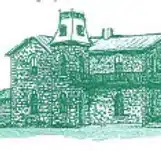 James H. Ward House, 403 8th St. (Built 1883)
James H. Ward House, 403 8th St. (Built 1883)
Ward's own house is one of New Mexico's finest Italianate Villas. Light-colored round arched window molding stones contrast handsomely with precision-cut brownstone walls. A square corner tower with mansard roof and cast-iron cresting accents the asymmetry and massing of the house plan. The original cast-iron balcony and Victorian metal yard fence remain intact.
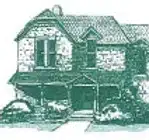 717 Jackson (Built 1890-1895)
717 Jackson (Built 1890-1895)
The home was apparently built for A.P. Buck, a local rancher. The stepped-back asymmetrical roof plan (with truncated front gable and full-length dormer windows) is typical of the Queen Anne style. Here, however, the eclectic design sensibilities of the Victorian era are evident, as the porch columns represent yet another design variation in the seemingly infinite array of folk Victorian spindle-work common throughout Las Vegas. The contractor was James H. Ward.
El Fidel Hotel, 500 Douglas Ave. Built (ca. 1921-23)
The site of the El Fidel Hotel was originally occupied by a two-story frame hotel built in the early 1880s. After World War I, automotive travel increased along US Highway 85, and civic leaders secured pledges to build improved accommodations for travelers. Built by M.M. Sundt in a fusion of Art deco and Mission Revival styles, "The Meadows Hotel" was christened in June 1923. In 1946 it was purchased by Toufick Fidel of Albuquerque who removed much of the facade's elaborate Mission Revival cast stone decoration and renamed it El Fidel.
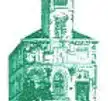 Old City Hall, 628 6th St. (Built 1892)
Old City Hall, 628 6th St. (Built 1892)
The former City Hall is the State's other finest example of the Richardsonian Romanesque style and has the distinction of being the first municipal building erected in New Mexico. The large, heavy stone arches on the ground floor are of the Richardsonian Romanesque style. The contrasting reddish-brown and light tan sandstone was locally quarried and cut. Note the carved winged eagles that flank the main entrance. The massive stone tower recalls that of Louis Sullivan's famous Civic Auditorium in Chicago.
 Gordon Jewelers, 606 Douglas Ave. (Built 1890-98)
Gordon Jewelers, 606 Douglas Ave. (Built 1890-98)
Many Las Vegans knew Gordon Jewelers by its distinctive street clock, made of cast iron and featuring classical detailing. The store-front is relatively intact, with leaded glass transom windows in excellent condition. Designed by Rapp and Rapp, Gordon Jewelers feature a tan-colored Roman brick facade similar to its neighbor, Murphey's Drug Store. Pressed-metal flourishes over the central part of both building bays are classical detailing in the Beaux-Arts tradition.
Union Block, 517 6th St. (Built 1881)
One of the most significant commercial Victorian facades in the Douglas Avenue/Sixth Street district now houses offices of the Community First Bank and other professionals. The building's original pressed metal cornice was modified with a tile hood about 1908.The attached neon sign from the second story is an interesting remnant from the 1950s and was recently relocated to the Crockett Building.
City Museum and Rough Rider Memorial Collection, 727 Grand Ave. (Built ca 1940)
Housed in a Works Project Administration ("WPA") structure built to serve as city hall, the City Museum provides a snapshot of life in the 1800s and 1900s. A remarkable collection of household items, costumes, arms, ranching gear, tools and furniture has been donated by a variety of community members over the years. In 1898, when Teddy Roosevelt put out a call for troops to help liberate Cuba, New Mexico Territorial Governor Miguel Otero offered to send a rifle brigade from New Mexico. The War Department formed the First Regiment of the United States Volunteer Cavalry made up of cowboy volunteers from across the West. The largest contingent from one state or territory came from New Mexico, and Las Vegas hosted the group's first reunion in 1899. Many reunions later, the Rough Riders veterans established a collection of mementos including historic photos, flags, and original uniforms.
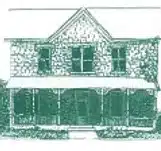 725 Jackson (Built 1886)
725 Jackson (Built 1886)
This house also uses contrasting stone window lintels and walls as decorative devices. The massing of the house suggests formal, symmetrical (and therefore, Classical) influence. The porch retains a fanciful, lacy design suggesting folk Victorian spindle-work. The railroads provided local lumber yards with pre-cut detailing from distant mills, and James H. ward, as the builder, simply grafted these porch columns onto his elegant stone houses. The house has been a movie set for Wyatt Earp and All the Pretty Horses.
Douglas-Sixth Street/North New Town Historic Districts
By 1882 Las Vegas had exploded to nearly 6,000 residents, and a new commercial district centered on Douglas Avenue and 6th Street was thriving. Within 20 years, this district was the site of some of the finest commercial buildings in New Mexico built in a grand variety of styles. Substantial institutions such as the city's banks, the Masonic Temple, the Tamme/Duncan Opera House, the YMCA and City Hall were located in the neighborhood.
Masonic Temple, 514 Douglas Ave. (Built 1894-95)
According to University of New Mexico architectural historian Chris Wilson, the Masonic Temple is one of the finest surviving examples of Richardsonian Romanesque style in New Mexico (see also Old City Hall). Designed by Rapp and Rapp it is cosmopolitan in its design and craftsmanship. The stone work is locally quarried purple sandstone. The carved details flanking the main tower entrance are inspired by the great Chicago architect Louis Sullivan. The second floor once housed the Montezuma Club, a group of wealthy bachelors. For many years Hoffman & Graubarths, the elegant haberdashery and clothing store, was located on the ground floor.
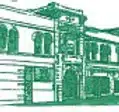 Crockett Block (Murphey's Drug Store), Corner of Douglas & 6th (Built 1898)
Crockett Block (Murphey's Drug Store), Corner of Douglas & 6th (Built 1898)
Built on the site of the St. Nicholas Hotel, the Crockett Block signified a resurgence in the local economy after an economic panic of 1893. A Rapp and Rapp dsign, the building reflects the California Mission style introduced to Las Vegas a year earlier by the nearby hotel La Castaneda. Tile roofs on the corner pavilions and buff-colored Roman brick mark the new style. The design shows Rapp's distinctive Neo-Classical approach in the 6th Street entrance. Murphey's Drug Store's original interior with a suspended NeoClassical mezzanine and pressed-metal ceiling have been preserved by the new owners. The Murphey's Drug Store sign was relocated to the Sixth Street entrance.
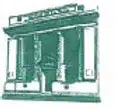 Bank of Las Vegas, 622 Douglas Ave. (Built 1921)
Bank of Las Vegas, 622 Douglas Ave. (Built 1921)
Designed by the Rapp and Rapp architects of Trinidad, Colorado, and Las Vegas, the Bank of Las Vegas is made of Missouri sandstone, cut and carved in St. Louis. Neo-Classical architecture, popular throughout the country at the time, is reflected by the fluted columns and Doric capitals, and the grand main entrance with its triangular pediment supported by twin consoles with a frieze of garlands.
Johnsen and Company Building, 619 Douglas Ave. (Built 1883)
